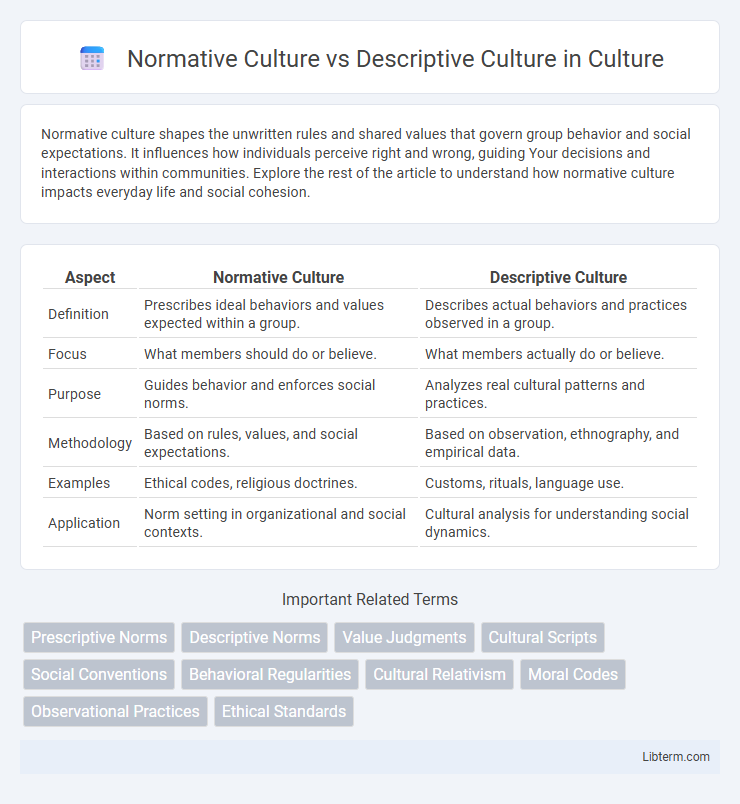Normative culture shapes the unwritten rules and shared values that govern group behavior and social expectations. It influences how individuals perceive right and wrong, guiding Your decisions and interactions within communities. Explore the rest of the article to understand how normative culture impacts everyday life and social cohesion.
Table of Comparison
| Aspect | Normative Culture | Descriptive Culture |
|---|---|---|
| Definition | Prescribes ideal behaviors and values expected within a group. | Describes actual behaviors and practices observed in a group. |
| Focus | What members should do or believe. | What members actually do or believe. |
| Purpose | Guides behavior and enforces social norms. | Analyzes real cultural patterns and practices. |
| Methodology | Based on rules, values, and social expectations. | Based on observation, ethnography, and empirical data. |
| Examples | Ethical codes, religious doctrines. | Customs, rituals, language use. |
| Application | Norm setting in organizational and social contexts. | Cultural analysis for understanding social dynamics. |
Introduction to Normative and Descriptive Culture
Normative culture encompasses the shared values, norms, and ideals that prescribe how members of a society should behave, forming a framework for acceptable conduct. Descriptive culture, by contrast, focuses on the actual practices, behaviors, and customs observed within a group, regardless of whether they align with prescribed norms. Understanding the distinction between normative and descriptive culture is essential for analyzing social dynamics and cultural consistency.
Defining Normative Culture
Normative culture refers to the shared values, beliefs, and norms that prescribe how members of a society should behave, establishing standards for acceptable conduct and social expectations. It embodies the ideal principles and moral codes that guide decisions and actions within a community, influencing laws, customs, and social roles. Defining normative culture involves understanding these prescriptive elements that shape collective behavior and maintain social order.
Understanding Descriptive Culture
Descriptive culture refers to the way people actually behave, think, and interact within a society, highlighting real-world practices and social patterns without judgment. It captures observable behaviors, customs, and traditions as they naturally occur, providing a factual basis for analyzing cultural dynamics. Understanding descriptive culture enables anthropologists and sociologists to study cultural diversity and social norms through empirical evidence rather than idealized standards.
Key Differences Between Normative and Descriptive Culture
Normative culture refers to the shared values, norms, and ideals that dictate how members of a society ought to behave, emphasizing prescriptive expectations and social rules. Descriptive culture, on the other hand, focuses on the actual behaviors, practices, and customs observed within a group, providing an empirical account of cultural reality. Key differences include normativity versus observation, with normative culture embodying ideals and descriptive culture reflecting lived experiences and actual social practices.
The Role of Norms in Shaping Society
Norms function as fundamental social regulations that dictate acceptable behavior within a society, serving as the backbone of normative culture by establishing expectations and standards. In descriptive culture, norms are observed and analyzed as empirical behaviors without judgment, reflecting how individuals actually act and interact in social environments. The interplay between these two perspectives illustrates how norms not only guide social conduct but also evolve through collective human behavior, reinforcing societal cohesion and facilitating cultural adaptation.
Real-World Examples of Normative Culture
Normative culture encompasses the shared values, norms, and expectations that guide behavior within a society, often reflected in laws, religious rules, and organizational codes. For example, the prohibition of alcohol in Saudi Arabia exemplifies normative culture influencing daily life, while the strict punctuality norms in Japan highlight societal expectations enforcing time discipline. Such real-world cases demonstrate how normative culture shapes individual conduct and social order through established regulations and collective beliefs.
Real-World Examples of Descriptive Culture
Descriptive culture refers to the actual behaviors, practices, and norms observed in a society, such as the widespread use of smartphones in South Korea or the tradition of siestas in Spain. This contrasts with normative culture, which embodies the idealized values and rules that people believe they should follow. Real-world examples include the discrepancy between the normative expectation of punctuality in Germany and the more relaxed, descriptive social tolerance for lateness in certain contexts.
Impacts on Social Behavior and Values
Normative culture defines the expected standards, rules, and values that guide social behavior, shaping individuals' conformity and promoting social order through shared norms. Descriptive culture captures actual behaviors and practices observed within a society, highlighting variations and deviations that influence social interactions and evolving values. The interplay between these cultural dimensions affects social cohesion, identity formation, and the adaptation of moral frameworks in communities.
Normative vs Descriptive Culture in Organizational Settings
Normative culture in organizational settings defines the ideal behaviors, values, and norms prescribed by leadership, shaping how employees are expected to act to align with company goals. Descriptive culture, on the other hand, captures the actual behaviors, practices, and shared experiences of employees, reflecting the lived reality within the organization. Understanding the gap between normative and descriptive culture helps leaders identify inconsistencies, improve employee engagement, and drive cultural change initiatives effectively.
Conclusion: Finding Balance Between Norms and Realities
Achieving a balance between normative culture, which prescribes ideal behaviors and values, and descriptive culture, which reflects actual practices and beliefs, is essential for organizational effectiveness and social cohesion. Recognizing divergences between these two cultural aspects allows for more realistic policy development and adaptive strategies. Integrating normative ideals with descriptive realities fosters a dynamic environment where cultural norms guide behavior while accommodating practical human experiences.
Normative Culture Infographic

 libterm.com
libterm.com